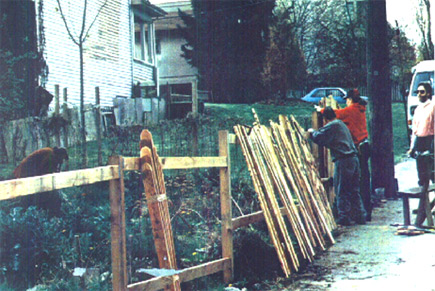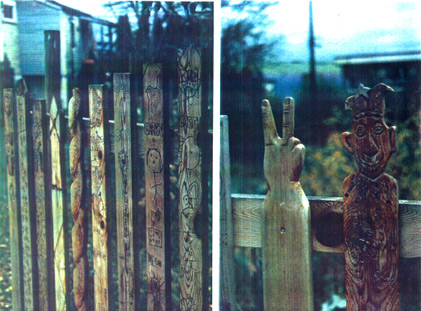Community Gardens As An Urban Planning Issue
Diana Hall
DianaHall@fvrd.bc.ca
A Thesis Submitted In Partial Fulfillment Of The Requirements For The
Degree Of Masters Of Planning In The Faculty Of Graduate Studies (School
Of Community And Regional Planning)
The University Of British Columbia April, 1996
The "Abstact" "Table of Contents" "Preface and "Summary" are included on this HTML page.
The complete thesis (20,000 words) is available as a Word doc (300K) here.
Abstract
This thesis develops the argument that community gardens have many social benefits making them a worthwhile urban amenity. The thesis question is: how can community gardens be implemented to maximize social benefits while overcoming obstacles and minimizing conflicts?
The literature review describes how community allotment gardens developed and evolved, in a North American and European context. Community gardens are then discussed from a planning perspective. For this purpose, planning literature about sustainable communities is examined for its relevance to community gardens.
The information collected directs the inquiry into a case study: The Mount Pleasant Neighbourhood Garden. Through interviews with local activists and an analysis of relevant articles, this case study examines the benefits of this community garden and the obstacles that were faced in the process of implementing it. Lessons from this case study are then applied to the planning of a community garden in the Burnaby Heights Area. For this purpose, a committee was formed. The information provided by this committee was collected in a focus group format. In addition, this section chronicles the correspondence with different municipal departments.
The general purpose of this study is to demonstrate the validity of the provision for community gardens in urban planning. The process of implementing a community garden will demonstrate the problems facing local activists, and illuminate why the role of planners is so crucial.

Fence Project: Community Art

Table Of Contents
Abstract
Table Of Figures
Preface
Acknowledgements
Chapter 2 Introduction
Rationale And Problem Statement
Methods
Chapter 3 A Historical And Theoretical Approach To Community Gardens
Introduction
Germany
France
United States
Canada
The Influence Of The Ncc'S Allotment Garden Program
The Strathcona Community Garden
Towards A Theoretical Approach To Community Gardens
Modernity And Its Effects
Community Gardens - An Incremental Step To Easing Urban Stress
Sustainable Communities
Summary
Chapter 4 Community Gardens - Social Benefits And Obstacles
Introduction
Social Benefits
The Role Of Greening In The Community
Aims Of Environmental Education
Obstacles
Political Power
Permanence
Neighbourhood Acceptance
Funding Problems
Policing Of Site - Bylaws, Etc. Enforcing Responsibility
Planner'S Attitudes To Community Gardens
Implications For Planning
Centralized Versus Local Control
Summary
Chapter 5 Case Study: The Mount Pleasant Neighbourhood Garden
Benefits Of Community Gardens
The Mount Pleasant Community Fence
Obstacles
Neighbourhood And Political Acceptance
Encouraging Responsibility
Funding
Park Board Guidelines
Other Community Landscape Initiatives
Summary
Chapter 6 A Community Garden In Burnaby Heights
Introduction
History And Background Of The Area
Demographic Changes
Problem Definition
Municipal Process Planning Episode
Legal Obstacles
Parks And Recreation Commission
Policy Implications
The Community Garden Committee - A Focus Group Format
Rationale And Communications Plan
Initial Questions And Approach
About The Participants
Refining The Original Proposal
Perceived Social Benefits
Overcoming Obstacles
Outcome Of The Focus Group Research
Summary
Chapter 7 Conclusion
What Can Planners Do?
Summary
References
Table Of Figures
A Place To Sit
A Place Where Everyone Is Welcome
Pathways Through Beautiful Scenery
Wildlife Habitat
Bridges The Gaps Between Cultures
Provides Benefits For All Ages
The Finished Fence - Community Created Public Art
Context Map
Map
Photo
Preface
In my North Burnaby neighbourhood, I am blessed with an abundance of green space, and an urban trail system connecting me ultimately to UBC, should I wish to ride my bike there. But also, on this green space, there are several fruit trees - remnants from former residential sites that have been allowed to remain. I make it my fall ritual to collect their fruits. These excursions provide me and other residents an enormous sense of satisfaction. Not only do we enjoy the peaceful excursions of walking in the neighbourhood, but we also benefit from the productive activity. In addition, there are many wildlife species in the area. I have seen deer, raccoons, coyotes, raptors, and frogs. This green space is minimally maintained (mowed twice yearly by civic authorities) and expansive. I had thought for many years, "why can't more fruit trees be planted in the area so that more people could enjoy their benefits?".
My orientation week at the School of Community and Regional Planning included a walking tour of the Strathcona Gardens. With its wild habitat, frog pond, espaliered fruit trees, interesting pathways, and colourful patchwork of allotment parcels, this garden made me realize what was possible. While part of the garden is divided for private use, the common amenities welcome non-gardeners as would a more formal park. But the allotment parcels, with their intensive cultivation, and personalized expression, provide a visual interest that no professional landscaping could approximate.
The common areas and fence at the Mount Pleasant Neighbourhood Garden provide a similar experience. This fence, with its individually crafted pickets demonstrates the success of this project in incorporating local involvement. In spite of their current successes, though, both gardens represented struggles by local activists in their implementation. Land use conflicts, as well as local governments who were hostile to the idea made the projects difficult.
Thinking that community gardens were a brilliant use of urban land, with benefits that extend beyond the immediate user, I wished to explore the idea more academically, within an appropriate theoretical framework. It was for this reason I chose the topic as my thesis. In addition, I wished to implement a community garden in my own neighbourhood, and have begun the process. At present, my proposal for such a garden is under review by the Burnaby Parks and Recreation Commission. This combination of both practical and theoretical approaches to the subject has been invaluable. I believe that community gardens are an important consideration for sustainable communities. However, my practical experience has given me some insight into the difficulties that local activists can face in developing community gardens.
I am fortunate enough to be working with a sympathetic planning department- their advice to my community association for getting this project accepted has been invaluable. And projects of this nature represent interesting opportunities - how planners can work with local activists.
Summary
Community Gardens are an intensive use of recreational land, inviting creative activity in the manipulation of the landscape. While individually leased parcels invite private stewardship, connecting pathways and common amenities encourage public use and enjoyment (albeit more passively). It is these common features that typify the more successful community gardens in the Lower Mainland. The Strathcona Community Garden and the Mount Pleasant Garden are two highly successful examples. More generally the benefits of community or allotment gardens are long term, and adaptable to changing circumstances. Because they restore a public realm to urban existence, community gardens are elements for consideration in planning for sustainable communities.
Because of their social benefits, it is appropriate for planners to have a role in the implementation of community gardens. A relatively passive approach would be that of facilitator, whereby the project is initiated within the local community. In this case, the planner would assist community members to make sure their projects are approved by municipal councils. A more active approach could involve the planner initiating the project. The possible means for implementation could be through zoning changes, or by negotiating with developers for the provision of community gardens.

![[new]](new01.gif)
